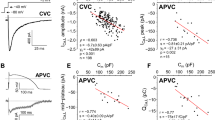Abstract
The Paramecium cell membrane was voltage-clamped under K current suppression conditions. Ciliary beating was registered using high-speed video microscopy. Depolarizing step pulses activated a transient inward current and induced reversed ciliary beating. Very strong positive steps inhibited ciliary reversal during the pulse suggesting inhibition of the Ca influx. We call the potential, which is sufficiently positive to induce transition from reversed to normal ciliary beating, the transition potential. The transition potential rose with increasing external Ca2+ showing saturation beyond 1 mM Ca2+. Addition of Mg2+, Ba2+ or K+ to the 1 mM Ca2+ bathing solution depressed the transition potential in a concentration-dependent manner. The depolarization-activated inward Ca current increased with rising external Ca concentration, and addition of either Mg2+, Ba2+ or K2+ diminished the inward Ca current. The diverging results of Ca2+-dependent positive shifts, and Mg2+-(Ba2+-, K+-) dependent negative shifts in transition potential are compared with shifts of VImax. It is concluded that external cations bind competitively — in addition to membrane surface charges — to affinity sites of Ca channel, where they specifically modulate permeation of calcium.
Similar content being viewed by others
References
Almers W, McCleskey EW (1984) Nonselective conductance in calcium channels of frog muscle: Calcium selectivity in a single-file pore. J Physiol (Lond) 353:585–608
Ballanyi K, Deitmer JW (1984) Concentration-dependent effects of Ba2+ on action potentials and membrane currents in the ciliate Stylonychia. Comp Biochem Physiol 78A: 575–581
Brehm P, Eckert R (1978) Calcium entry leads to inactivation of calcium channel in Paramecium. Science 202:1203–1205
Cota G, Stefani E (1984) Saturation of calcium channels and surface charge effects in skeletal muscle fibers of the frog. J Physiol (Lond) 351:135–154
De Peyer JE, Deitmer JW (1980) Divalent cations as charge carriers during two functionally different membrane currents in the ciliate Stylonychia. J Exp Biol 88:73–89
De Peyer JE, Machemer H (1982) Electromechanical coupling in cilia. I. Effects of depolarizing voltage steps. Cell Motility 2:483–496
Dunlap K (1977) Localization of calcium channels in Paramecium caudatum. J Physiol (Lond) 271:119–133
Ganitkevich V YA, Shuba MF, Smirnof SV (1988) Saturation of calcium channels in single isolated smooth muscle cells of guinea-pig taenia caeci. J Physiol (Lond) 399:419–436
Hagiwara S, Takahashi K (1967) Surface density of calcium ions and calcium spikes in the barnacle muscle fiber membrane. J Gen Physiol 50:583–601
Hess P, Lasman JB, Tsien RW (1986) Calcium channel selectivity for divalent and monovalent cations. Voltage and concentration dependence of single channel current in ventricular heart cells. J Gen Physiol 88:293–319
Hess P, Tsien RW (1984) Mechanism of ion permeation through calcium channels. Nature (Lond) 309:453–456
Hille B (1992) Ionic channels of excitable membranes. Sinauer Associates Inc. Sunderland, Massachusetts
Hinrichsen RD, Saimi T (1984) A mutation that alters property of the calcium channel in Paramecium tetraurelia. J Physiol (Lond) 351:397–410
Ling K-Y, Kung C (1980) Ba2+ influx measures the duration of membrane excitation in Paramecium. J Exp Biol 84:73–87
Machemer H (1986) Electromotor coupling in cilia. In: Lüttgau HC (ed) Membrane control of cellular activity. Fortschr Zool 33:205–250
Machemer H (1988a) Electrophysiology. In: Gortz HD (ed) Paramecium. Springer, Berlin Heidelberg New York Tokyo, pp 185–215
Machemer H (1988b) Motor control of cilia. In: Gortz HD (ed) Paramecium. Springer, Berlin Heidelberg New York Tokyo, pp. 216–235
Machemer H (1989) Cellular behaviour modulated by ions: electrophysiological implications. J Protozool 36:463–487
Machemer H, Eckert R (1973) Electrophysiological control of reversed ciliary beating in Paramecium. J Gen Physiol 61:572–587
Machemer H, Eckert R (1975) Ciliary frequency and orientational responses to clamped voltage steps in Paramecium. J Comp Physiol 104:247–260
Mogami Y, Pernberg J, Machemer H (1990) Messenger role of calcium in ciliary electromotor coupling: A reassessment. Cell Calcium 11:665–673
Naitoh Y (1968) Ionic control of the reversal response of cilia in [itParamecium caudatum. A calcium hypothesis. J Gen Physiol 51:85–103
Naitoh Y, Kaneko H (1972) ATP-Mg-reactivated triton-extracted models of Paramecium: modification of ciliary movement by calcium ions. Science 176:523–524
Naitoh Y, Yasumasu I (1967) Binding of Ca ions by Paramecium caudatum. J Gen Physiol 50:1303–1310
Nakaoka Y, Machemer H (1990) Effects of cyclic nucleotides and intracellular Ca on voltage-activated ciliary beating in Paramecium. J Comp Physiol A 166:401–406
Nakaoka Y, Tanaka H, Oosawa F (1984) Ca2+-dependent regulation of beat frequency of cilia in Paramecium. J Cell Sci 65:223–231
Ogura A, Takahashi K (1976) Artificial deciliation causes loss of Ca-responses in Paramecium. Nature 264:170–172
Pape HC, Machemer H (1986) Electrical properties and membrane currents in the ciliate Didinium. J Comp Physiol A 158:111–124
Preston RR, Saimi Y (1990) Calcium ions and the regulation of motility in Paramecium. In: Bloodgood RA (ed) Ciliary and flagellar membranes. Plenum Publ Corp New York, pp 173–200
Preston RR, Saimi Y, Kung C (1990) Evidence for two K+ currents activated upon hyperpolarization of Paramecium tetraurelia. J Membrane Biol 115:41–50
Saimi Y, Kung C (1982) Are ions involved in the gating of calcium channels? Science 218:153–156
Satow Y, Kung C (1979) Voltage sensitive Ca-channels and the transient inward current in Paramecium tetraurelia. J Exp Biol 78:149–161
Tsien RW, Hess P, McCleskey EW, Rosenberg RL (1987) Calcium channels: Mechanism of selectivity, permeation, and block. Annu Rev Biophys Biophys Chem 16:265–290
Author information
Authors and Affiliations
Rights and permissions
About this article
Cite this article
Nakaoka, Y., Teunis, P., Weskamp, M. et al. Cationic inhibition of Ca current and Ca-dependent ciliary responses in Paramecium . J Comp Physiol A 174, 77–82 (1994). https://doi.org/10.1007/BF00192008
Accepted:
Issue Date:
DOI: https://doi.org/10.1007/BF00192008




